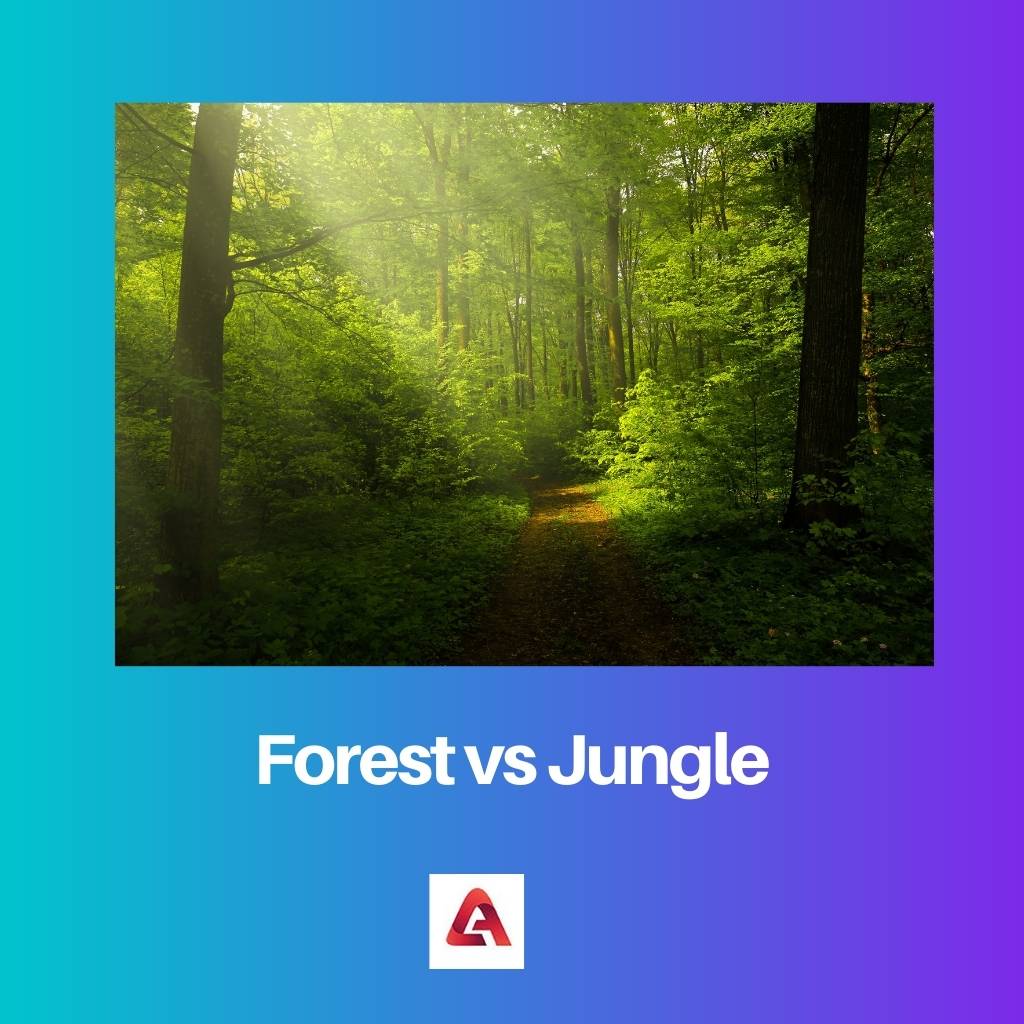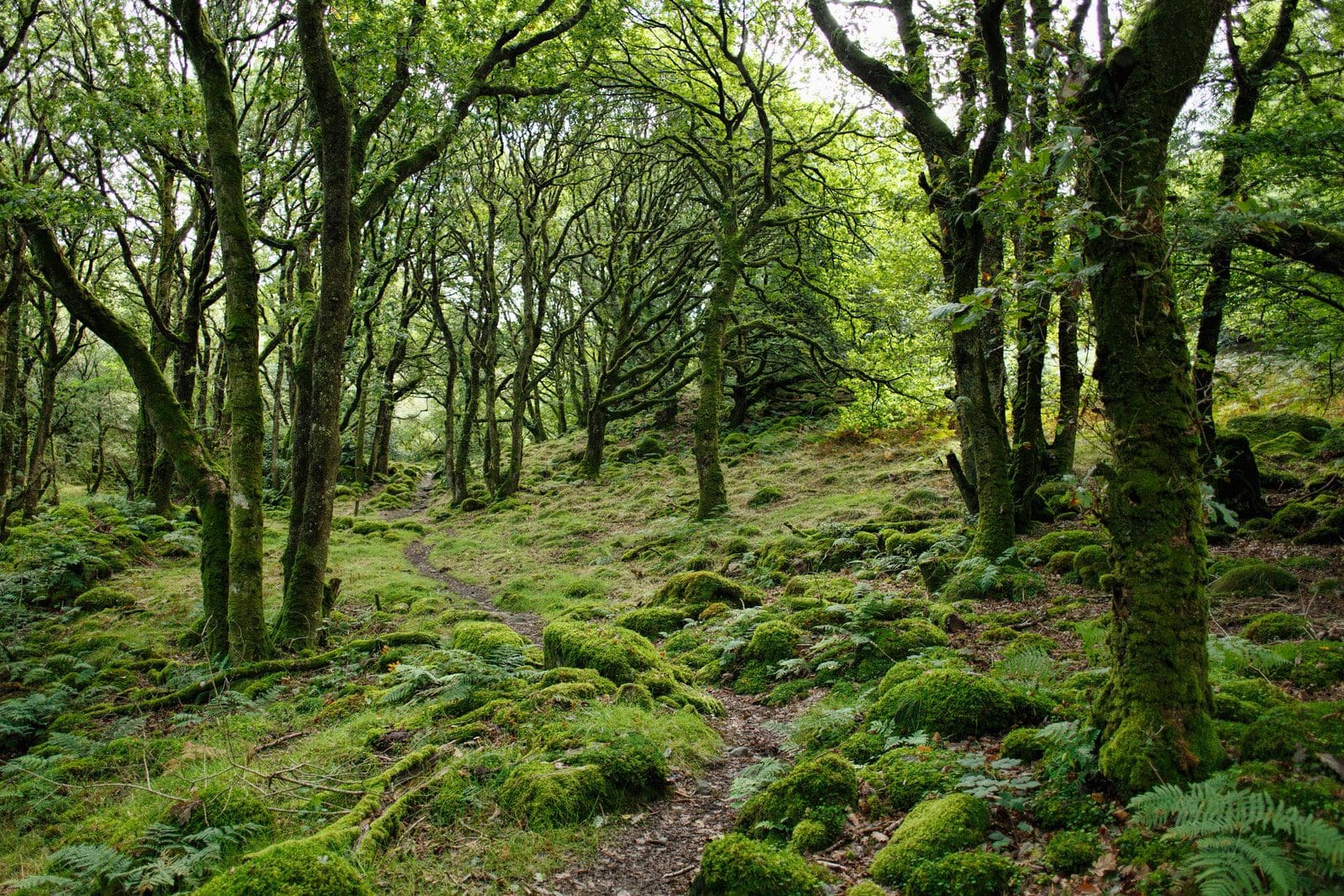Nature means the universe in which we live. It refers to climate, geology, wildlife, etc. Nature is the realm in which various inanimate objects, plants, animals, etc., live. The term ‘Nature’ means something supernatural or not created by the human mind.
Life sustains on earth via nature through the process of growth, adaptation, organization, metabolism, response to stimuli, and reproduction. It consists of forests, jungles, rocks, mountains, oceans, etc.
Key Takeaways
- Forests are characterized by a dense canopy of trees, which can be categorized into several types, such as deciduous, coniferous, or mixed.
- Jungles are tropical rainforests characterized by their high biodiversity and warm and wet climate year-round.
- Forests are more manageable and accessible for human activities, whereas jungles are denser, making them difficult to traverse.
Forest vs Jungle
A forest is a large area covered by tall, less dense trees and vegetation that can be traveled through by humans and are warm. A jungle is a large area covered by tangled or overgrown denser vegetation. It is penetrated by less sunlight, has more moisture, and has a tropical or humid climate.

The forest is a particular area that mainly consists of trees. All over the world, hundreds of forests can be found.
According to the Food and Agricultural Organization (FRA), forests should have land that should be more than 0.5 hectares, its trees should be higher than 5 meters, and the forest cover should be more than 10 percent.
Then only it can be considered as a forest. It contains the terrestrial ecosystem of the earth. Majorly half of the global forests are found in five countries only.
A jungle is something which is a land in the forest only. But it is dense and impenetrable. Earlier tropical forests were considered jungles. But after the year 1970s, this practice has gone out of use.
Jungles occur in all of the land masses in the world. It is very rich in flora and fauna, numerous vegetation can be found, climatic conditions are good, and wildlife also thrives here.
Comparison Table
| Parameters of Comparison | Forest | Jungle |
|---|---|---|
| Size | Very Large | Small (20% of forest) |
| Penetration | Penetrable | Impenetrable |
| Type | Evergreen, Coniferous, Boreal, Deciduous, Tropical, Rain etc. | RainForests |
| Found in | All regions | Edge of Forest |
| Canopy | Thick | Thin |
| Diverse | Less Diverse | More Diverse |
What is Forest?
The word Forest comes from the Old French word ‘fores’, meaning which is very vast, covered in trees. Forest doesn’t have an exact definition, but it is presumed that an area of land is covered by trees.
Almost 800 definitions of forest exist globally. Earlier, forest meant land which was for hunting or obtaining wood. Exactly it is not known when this word came into use. But in the Norman period, forests held a very important role as it was an uninhabited land and was suited for hunting.
Forests evolved on Earth some 380 million years ago in the Late Devonian period. It is at that time only Archaeopteris evolved, which was both fern and tree-like. It is believed that Archaeopteris formed the first forest because it spread all over from the equator to polar regions.
Forests consist of 75% of Earth’s biomass, and it is also responsible for 80% of plant biomass on Earth. The ecosystem of forests can be found everywhere where trees are capable of growing.
Forest contains many components, among which two are biotic and abiotic components. Biotic means living, and abiotic means non-living. Forest consists of many different layers, among which the understory, canopy, and forest floor are the most important.
It can be divided into various types as well, like Sub-tropical, Boreal, Tropical, Coniferous, Evergreen, Deciduous, etc. According to a survey in 2015, the total number of trees in the forest is approximately 3 trillion in the world.
It has many advantages, like it purifies water, reduces CO2, acting as a carbon sink, source of woods, lumber, reserves, etc.

What is Jungle?
The word jungle comes from the Sanskrit word ‘jangala,’ which means arid and rough. The word came from Bengali into the English language in the 18th century. However, the jungle has been used in Indian subcontinents and the Iranian plateau for many centuries.
It meant plants that grow in the old forest or in an area where vegetation has taken over because of unkemptness. Jungles are impenetrable because trees and plants are very dense, and light can’t penetrate them easily.
Due to its denseness, it restricts human movement, unlike forests where humans can move easily. Earlier tropical forests were referred to as jungles, but after the 1970s, this notion changed completely.
The jungle is a type of rainforest, and it is found mostly at the edge of the forest. The jungle constitutes the part of a forest where vegetation, flora, and fauna are very rich. The jungle covers only 20-30% of the forest area. It can be mainly seen in the trophic region.
Jungles are overgrown, and their vegetation is also tangled. That is why it hinders movement, and trees and plants are to be cut to move along. This is what makes it different from the forest.
Jungles can also exist inside the forest as well, or they may be created either due to human activity or through hurricanes. Mangroves and Monsoon forests belong to this type. The jungle also has a large open canopy area. Only one rule survives in the jungle, i.e., Survival of the fittest.

Main Differences Between Forest and Jungle
- Forest are very large in size, and it consists of various types of forests. The jungle is small in size, and it constitutes only 20-30% of the forest.
- Forests are penetrable as light can easily pass through vegetation, and movement is very easy. The jungle is impenetrable as it is dense and hinders movement.
- Various types of forests are there, like Boreal, coniferous, evergreen, temperate, deciduous, etc. The jungle is a kind of rainforest.
- Forests are found in almost every part of the world. The jungle is found on the edge or within the forest, created naturally or artificially.
- The forest has a thick canopy cover. The jungle has a thin canopy cover.
- Vegetation and flora are less diverse in forests. Vegetation and Flora are more diverse in Jungle.

- https://books.google.com/books?hl=en&lr=&id=XMFWrpV2W7EC&oi=fnd&pg=PR5&dq=Forest+and+Jungle&ots=7eBihudwMk&sig=XpiMLT91a7qwXtCV2_UaSkz5aco
- https://www.jstor.org/stable/4414266

The distinction between forests and jungles based on size, penetration, and biodiversity offers a comprehensive understanding of these diverse landscapes. Thank you for the insightful comparison.
Indeed, Lizzie. It’s crucial to acknowledge and appreciate the diverse natural environments that exist and understand their role in supporting life on Earth.
I couldn’t agree more, Lizzie. This article provides in-depth knowledge about the unique characteristics and ecological significance of forests and jungles.
The historical background and evolution of forests and jungles are enlightening. Learning about the origins of these natural formations helps in understanding the impact of nature on our planet.
Well said, Arthur. It’s truly fascinating to explore the rich history and ecological importance of natural habitats.
The comparison table illustrating the differences between forests and jungles is very well-explained. It’s an excellent way to grasp the distinctive features of these natural habitats.
I share your sentiments, Holly. The detailed comparison provides valuable insights into the complexities and significance of forest and jungle ecosystems.
The detailed comparison between forests and jungles was very informative. Understanding the characteristics and features of each helps to appreciate the unique ecosystems they support.
Absolutely, Abigail. It’s intriguing to delve into the complexities of nature and learn about the significance of forests and jungles.
The historical and etymological origins of the word ‘jungle’ and its transition over time provided an intriguing dimension to the discussion. Understanding the linguistic and ecological contexts is enriching.
Absolutely, the information about the linguistic evolution of the term ‘jungle’ is truly captivating. It’s interesting to delve into the origins and cultural meanings associated with these natural landscapes.
I couldn’t agree more, Amber. The comprehensive exploration of historical and linguistic aspects adds depth to the understanding of natural environments.
The historical origins of the terms ‘forest’ and ‘jungle’ and the assessment of their characteristics over time are truly enlightening. This in-depth information deepens our understanding of natural environments.
Absolutely, understanding the historical and ecological aspects of forests and jungles enhances our awareness of the crucial role of nature in sustaining life.
I completely agree with your perspective, Qholmes. The historical context provides a holistic view of the evolution of these natural habitats.
The ecological role and environmental impact of forests and jungles are illuminated through this comprehensive discussion. It’s essential to recognize the significance of these natural ecosystems.
Well stated, Duncan. The informative content of this article contributes to a deeper appreciation of the natural world and its diverse habitats.
The enumeration of the biotic and abiotic components of forests, along with the diverse layers within them, offers an insightful understanding of forest ecosystems and their multifaceted nature.
I share your view, Charrison. The detailed insight into the components of forests enhances our appreciation for the complexity of natural habitats.
Thank you for explaining the differences between forests and jungles in such detail. It’s fascinating to learn about the diverse ecosystem of these natural environments.
I completely agree with you, Marshall. The information provided is really insightful and enriching.
The detailed account of the historical and biological aspects of forests presents a comprehensive overview of these natural environments. The article is educational and offers valuable insights.
I share your perspective, Lola. The informative content of the article broadens our understanding of the historical and ecological context of forests.